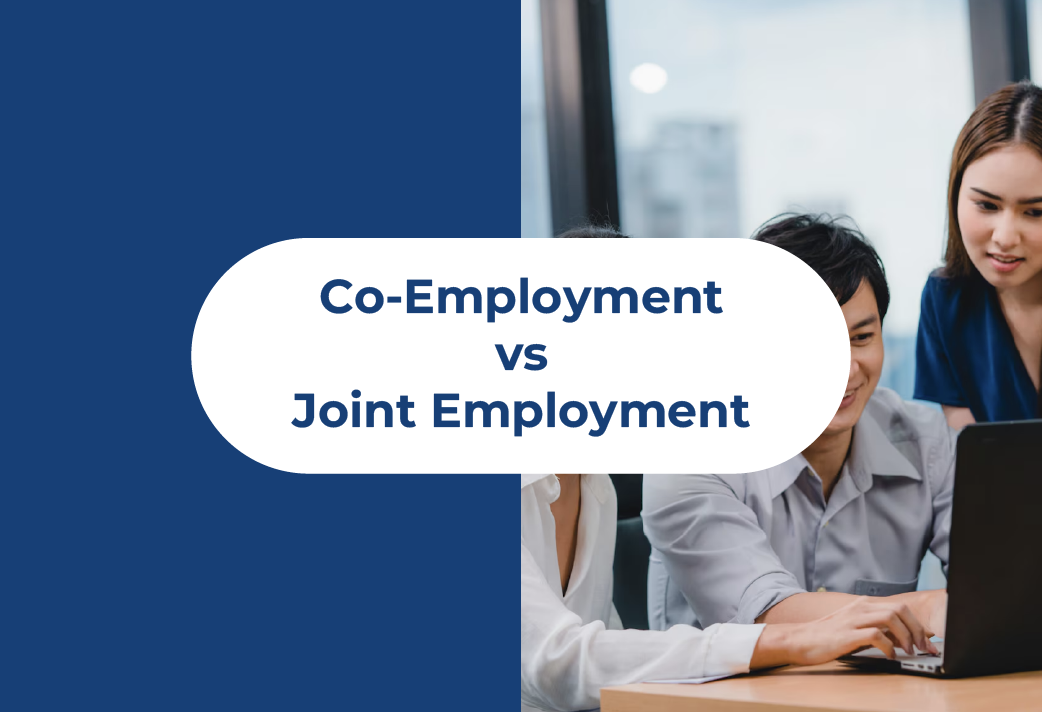Labor law can cause big problems or delays for companies, especially those seeking new talent overseas, but fortunately, there are ways to reduce the labor burden put upon these global employers. In this case, two employment structures that frequently come into play are co-employment and joint employment. Understanding the distinctions between these models can be crucial for companies that want to optimize their workforce management strategies and ensure compliance with local regulations around the world. To this end, this article looks at the definitions, examples, and key differences between the similar yet different co-employment vs. joint employment and discusses how businesses can prepare for the impact of each on payroll while enjoying their benefits.

Tired of scrolling? Download a PDF version for easier offline reading and sharing with coworkers
What is Co-Employment?
Co-employment, also known as employee leasing or Professional Employer Organization (PEO) arrangements, is a contractual relationship between two employers—a client company and a PEO.
A PEO is a third-party services provider offering professional and expert support in key HR functions.
In this model, the PEO becomes the official employer for the workers of the client company, handling specific HR functions such as payroll, benefits administration, tax compliance, and other employment-related responsibilities.
Meanwhile, the client company retains control over the day-to-day management and job duties of the employees.
Common Examples of Co-Employment
Small Business Outsourcing HR Functions – A small business may partner with a PEO to manage its HR tasks, allowing the business to focus on its core operations while the PEO handles payroll, benefits, and compliance with labor laws. This can be done by the company to avoid the hassle or cost of overseeing these functions itself.
Startups Scaling Rapidly – A startup experiencing rapid growth might engage a PEO to quickly scale its workforce management without the admin burden of hiring and managing employees directly.
Companies Expanding Internationally – The most commonly seen situation for co-employment. In these cases, a company expanding into new markets can use a PEO to navigate the complex and often unfamiliar employment laws of the new country, ensuring compliance while being able to focus on properly managing local employees.
What is Joint Employment?
Joint employment occurs when two or more entities share control over an employee’s work. In this scenario, both entities are considered employers and are jointly responsible for complying with employment laws.
Agreements may, therefore, be made by employees with both parties.
Joint employment is often used in situations where a company uses a staffing agency or subcontractors to provide labor.
Examples of Joint Employment
Staffing Agency Arrangements – A company hires workers through a staffing agency to outsource the labor burden. In this case, the agency recruits and pays the employees, but the company controls their day-to-day work and working conditions.
Franchise Models – A franchisor and franchisee may be considered joint employers if they both exercise significant control over an employee’s work conditions and employment terms.
Co-Employment vs. Joint Employment: Key Differences
While both co-employment and joint employment arrangements involve multiple parties sharing some element of the resulting employment responsibilities, they differ in terms of structure and implications.
In 2025, the difference between these types of working relationships is once again in the public attention. Legal experts around the world are more and more debating the finer points of alternative contracting types due to the rowing presence of remote, flexible, or casual working agreements. The legal responsibilities entailed are thus important to define now to avoid potential problems later, such as in the case of a recent dispute in the US in which the issue of joint employment helped to confuse and complicate discussions around liability.
As these cases are changing the discussion around how employees and employers interact all the time, it’s essential to clarify administrative burden factors defining co-employment vs joint employment early on, based on the following:
Nature of the Relationship
Co-Employment – Involves a client company and a PEO (or local equivalent) where the PEO is the official employer and manages HR functions while the client company directs day-to-day work. In this case, each party has liability concerning some element of the employee’s work or needs.
Joint Employment – Involves two or more entities with shared control over employees, both bearing legal responsibility for employment conditions and compliance. In this case, both parties share liability over all elements of an employee’s work or needs.
Control and Responsibility
Co-Employment – The client company retains control over job duties and performance, while the PEO solely handles administrative HR tasks.
Joint Employment – Both entities share legal control over work conditions, job duties, and regulatory responsibilities related to employment.
Legal and Compliance Implications
Co-Employment – The PEO assumes many legal and compliance responsibilities, reducing the client’s risk exposure.
Joint Employment – Both employers are jointly liable for compliance with labor laws, increasing each entity’s complexity and potential risk.
Impact on Payroll and Benefits
Co-Employment – The PEO manages payroll and employee benefits, often providing access to better benefits packages due to its larger pool of employees.
Joint Employment – Each employer may have separate payroll and benefits systems, complicating administration and compliance. However, a staffing agency may still take care of the client company’s share of payroll tax record-keeping, regulatory compliance, or admin on their behalf.
Worker Classification
Co-Employment – Employees are typically classified as the PEO’s employees for legal and tax purposes.
Joint Employment – Employees are considered employees of both entities at the same time, requiring careful coordination to ensure proper classification and compliance.
Preparing for the Impact of Each on Payroll and Benefits
Understanding the differences between co-employment vs joint employment is essential for businesses to prepare effectively for their impact on payroll and benefits.
The following areas are the most important in terms of what to look out for:
Payroll Management
Co-Employment – Working with a PEO simplifies payroll management by removing responsibility for its management from the client company. Here, the PEO handles all aspects of payroll, from processing wages to filing taxes, ensuring compliance with local and federal regulations, and reducing the chance of errors thanks to expertise and experience.
Joint Employment – Payroll management in a joint employment scenario requires careful coordination between the entities as both must ensure accurate wage calculations, timely payments, and proper tax withholdings. While this arrangement can still offer expert support, clear communication and well-built systems are essential to avoid compliance issues.
Benefits Administration
Co-Employment – PEOs often provide access to improved benefits packages, including health insurance, retirement plans, and other perks. This is because PEOs can pool employees from multiple clients and negotiate better rates and options than are possible for a single company.
Joint Employment – Each employer must ensure that any and all benefits offered by the client company in their initial contract comply with applicable laws. Coordination is key to preventing benefits duplication while ensuring that employees receive all entitlements.
Compliance and Legal Considerations
Co-Employment – The PEO assumes many key compliance responsibilities, from adhering to labor laws to managing workers’ compensation and unemployment claims. This can significantly reduce the client’s legal risks thanks to industry-level tools or knowledge.
Joint Employment – Both employers must be vigilant about compliance, as in this case, a failure by one entity can result in legal consequences for both. Regular audits and clear agreements are therefore crucial to manage this risk.
Conclusion: Make the Most of Alternative Employment Models with INS Global’s International Network of Employer of Record Services
Co-employment and joint employment are useful options for companies seeking different kinds of employment, whether it’s to grow global projects or simplify local labor burdens. However, both require a thorough understanding of the distinctions and implications involved.
INS Global offers the advantages of both models to suit your needs through Employer of Record (EOR) services designed to simplify international employment. As an EOR, INS Global assumes legal responsibility for employees, managing HR tasks, employment agreements, payroll, benefits, and compliance with local regulations.
By leveraging INS Global’s expertise, companies can confidently take on the challenges of co-employment and joint employment, ensuring that their workforce management strategies are effective, compliant, and conducive to business growth.
For more information on how INS Global can support your business, contact us today and take advantage of a free consultation with our expert expansion advisors.



SHARE